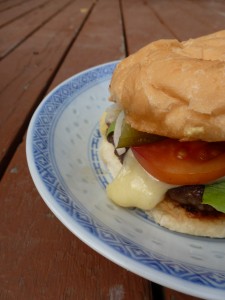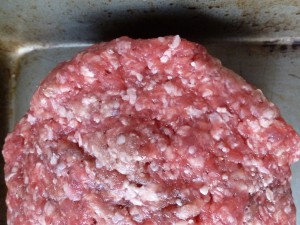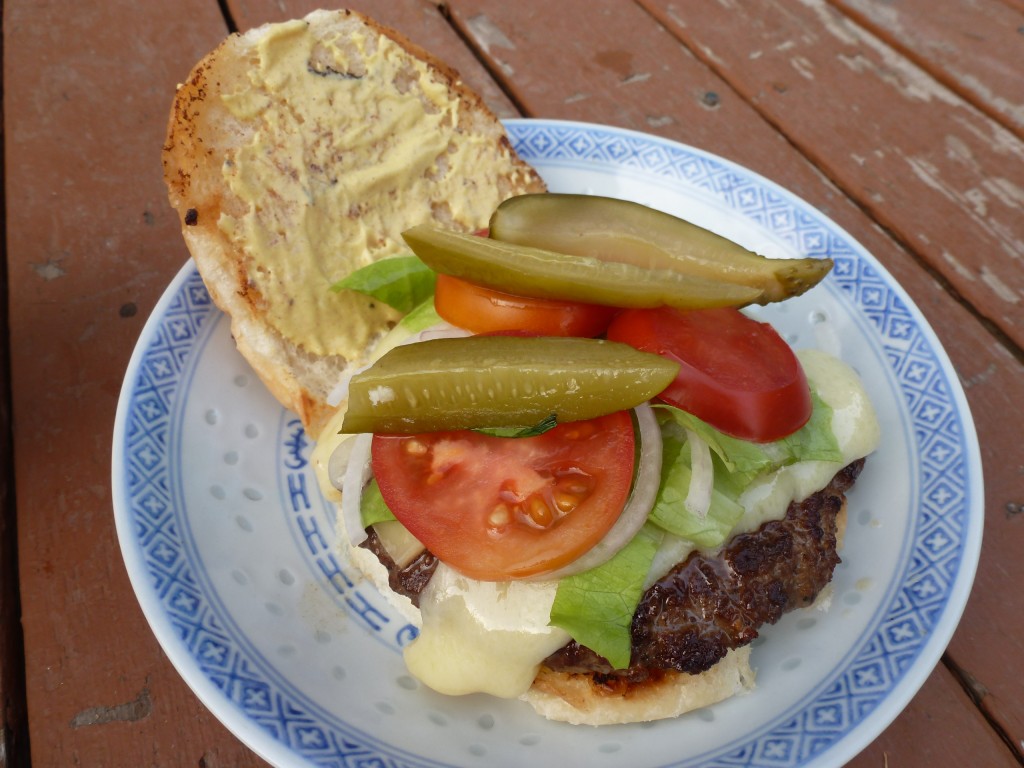Originally published September 29, 2012.
 This summer I had a little burger freak-out. I thought about hamburgers more in the last few months than my entire life previous, and I came to realize that, despite eating them for about twenty five years, I knew very little about them.
This summer I had a little burger freak-out. I thought about hamburgers more in the last few months than my entire life previous, and I came to realize that, despite eating them for about twenty five years, I knew very little about them.
The following burger info will be obvious to many of you, but circumstances conspired to stunt my burger knowledge from a very young age. For instance, the burgers I ate growing up were a bit like squished meatballs: they contained bread crumbs and eggs and were mixed to bind the ingredients together. They were tasty and comforting, but they hampered my understanding of proper hamburger flavour and texture for years. To aggravate the situation, I make sausages at work every week, and in days past I would often apply the same theories and practices to hamburgers.
In other words I had to unlearn everything that I thought I knew about burgers.
Let’s start at the beginning.
Beef. The best burgers are made from quality beef that you’ve ground yourself. Fat is important as a source of beefy flavour and moist mouthfeel. I aim for a fat content of roughly 25% by volume. There’s no science to achieving that ratio: you have to eyeball it. Chuck or brisket commonly form the bulk of the mixture, with leaner, cheaper cuts like flank and sirloin balancing it out. (Editor’s Note: a mixture of 2:1:1 brisket, flank, top round is a good starting point.). I grind my meat with one pass through a 3/16″ plate.
Of course, you can make good burgers with pre-ground meat, just make sure it’s not lean or, God forbid, extra-lean. I’ll say it again, in case the recent E. coli outbreaks haven’t already convinced you: only buy quality beef from trusted producers!
Other Ingredients. As I mentioned above, I grew up on homemade burgers that contained eggs and bread crumbs. Some burger joints swear by Worcestershire and granulated garlic. For reasons that will be discussed in the “Mixing” section below, I currently add two ingredients to my ground beef: salt and pepper.
One big way that burgers differ from sausages is salt content. If you season a burger mix as you would a sausage mix, for some reason the burgers taste way too salty. The right amount of salt is also important for the final texture of the patty. Salt aids in protein-extraction, and helps bind the ground meat together. This is something that we encourage in sausage-making, but discourage in burger-making. Again, this will be discussed further in the “Mixing” section. For sausages I take the weight of the meat and fat, divide by 60, and that is the amount of salt I add. For burgers I divide by 90. In other words my burgers have 2/3 the amount of salt that my sausages do, about 1.11% of the weight of the beef. Even this is fairly aggressive seasoning for a burger.
If you want to taste pepper in the final patty, add 0.2% of the weight of the meat in freshly ground black pepper.
Mixing. This is where my sausage-making background seriously affected my understanding of burgers. Sausages are ground meat, combined with salt and water, then mixed to develop a cohesive, springy texture. The large dose of salt helps extract proteins. The water and the mixing develop those proteins into a strong network, very much like kneading bread. Sausages are usually stuffed into casings. Sausage patties are not stuffed into casings, but they are still combined with salt and water and mixed prior to shaping, so that they have the resilient texture of a sausage.
Burgers are emphatically not sausage patties, because they have not been mixed. They have a texture all their own. To quote Harold McGee: “the gently gathered ground beef in a good hamburger has a delicate quality quite unlike even a tender steak.”
The most critical part of burger preparation, once the right grind has been selected, is to season and shape the patties without developing a protein network. We have lowered the amount of salt added because salt extracts protein from the meat. We have omitted all liquids, whether egg yolks or Worcestershire sauce, to discourage protein development. Now we must minimize mechanical agitation.
When grinding my own meat for burger mix, I add the salt and pepper to the cubed meat, before grinding. This way the salt is evenly distributed through the grind, without my having to mix the meat and develop the protein.
Working with pre-ground meat, I add the salt and pepper, then, instead of folding and compressing the meat, I pretend I’m tossing a delicate salad. I lift the ground meat, then let the individual strands fall between my fingers so that they don’t get pressed together.

Shaping. Gather the desired amount of seasoned, ground beef, then gently compress it between your palms, using your fingers to maintain the round shape of the patty.
The diameter of the patty should be tailored to the diameter of the bun. The height of the patty should be tailored to the size of the diner’s mouth. A lot of people like tall, messy burgers that you can barely get your mouth around. I don’t. I find that once the bun and condiments are in play, a final patty height of 3/4″ is all I can handle comfortably. My preferred thickness is even less: somewhere around 3/8″ or 1/2″.
Remember that the burger will shrink in diameter and grow in thickness as it cooks. The raw patty should therefore be a bit wider than the bun, and very thin. I start with a patty that is 5″ across, and 1/2″ tall. After cooking it will be 4″ across, and 3/4″ tall.
Cooking. The cooking of hamburgers is taken very seriously. Anthony Bourdain says to order a burger anything besides medium-rare is “un-American.” On the other hand it is actually illegal to serve a burger anything less than well-done in Canada, though apparently a few places are doing it.
Frankly I think the whole issue is overblown. Well-done burgers can be moist and tender, as long as they contain the right amount of fat and haven’t been over-mixed. Medium-rare burgers are safe to eat as long as the meat as been handled properly. I would never buy factory-raised, ground beef from a grocery store and eat it anything but well-done. At home, using quality beef that I have cut and stored myself, I aim to cook my burgers through, but if there’s some pink meat in the middle, I don’t freak out.
If you subscribe to Bourdain’s jingo and absolutely must prepare a medium-rare burger, here’s Harold McGee’s suggested method:
Bring a large pot of water to a rolling boil, immerse the pieces of meat in the water for 30-60 seconds, then remove, drain and pat dry, and grind in a scrupulously clean meat grinder. The blanching kills surface bacteria while overcooking only the outer 1-2 millimeters, which grinding then disperses invisibly throughout the rest of the meat.
Note that if you’re cooking a burger mid-rare, there will be less patty-shrinkage.
While there is a time and a place for cooking burgers on the barbecue, most afficianados maintain that very hot griddles or skillets are the ideal cooking surface. These methods don’t develop the open-flame char flavours of the barbecue, but you can get a very heavy, uniform crust on the flat sides of the burger. The crust has good flavour and a distinctive crunch. Burger-freaks call this “burger candy.”
Bun. My childhood burger was placed on a lean kaiser roll. We have gone to great length to avoid developing the protein in the meat so that we have a loose, tender amalgam of beef. If we put this burger on a kaiser bun, with its lean, glutenous chew, we have ruined dinner.
Burger buns should be tender and slightly sweet. Whichever bun you decide to use, show it some love and toast it. One of the advantages of cooking your patty on a griddle or in a skillet is that you’ll have a bit of burger fat in which to fry the bun.
Condiments. These are obviously a matter of personal taste. My own thoughts:
Some form of tomato is necessary. If I have fresh tomatoes, I use fresh tomatoes. If I don’t, I use ketchup. I don’t like using both. If I use fresh tomatoes, I add mustard. Raw onion and dill pickles are also required.
While I do have a soft-spot for processed cheese, I usually use gouda, Gruyere or Emmenthal for cheeseburgers. The younger versions have better melting properties. I find that the cheese-flavour is stronger if the slices are only partially melted. Overheating will thin out the cheese and make it run off the burger.
Money Shot
Addendum: Cherry Coke
Traditionalists will argue that I’m ruining coke; locavores will say I’m ruining Evans cherries.
This is my perfect cherry Coke, the ideal accompaniment for burgers, Montreal smoked meat, and fried chicken:
- 2 oz Appleton Rum
- 1 oz Evans cherry syrup
- 6 oz Classic Coke
Sources
My two main sources of burger info were Harold McGee’s On Food and Cooking and Heston Blumethal’s In Search of Perfection episode on the burger, which you can watch here.

